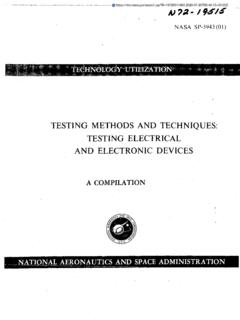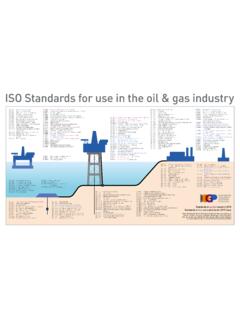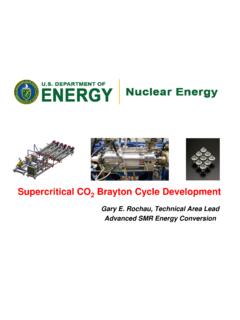Transcription of The James Webb Space Telescope Mission
1 The James Webb Space Telescope Mission Matt Greenhouse JWST Project Office NASA Goddard Space Flight Center 7 September 2015. @NASAWebbTelescp #JWST. 7 September 2015 Presentation to: The International Astronomical Union: Division B 1. JWST is designed to look back in time to see the first galaxies First Light (After the Big Bang). A Brief History of Time First luminous objects, proto-galaxies, supernovae of first stars COBE: The oldest light Credit: Rychard Bouwens 3. minutes HST: Most distant objects yet seen 300,000. years 100 million years 1 billion years billion years Millennium Simulation WMAP COBE HST Spitzer JWST. 7 September 2015 Presentation to: The International Astronomical Union: Division B 2. JWST will image the infrared universe with unprecedented clarity First Light (After the Big Bang). First luminous objects, proto-galaxies, supernovae, black holes Assembly of Galaxies Merging of proto-galaxies, effects of Galaxies when the universe was ~1 billion years old black holes, history of star formation 3.
2 Minutes 300,000. years 100 million years 1 billion years Galaxies today JWST. 7 September 2015 Presentation to: The International Astronomical Union: Division B 3. JWST will see how the structure and composition of galaxies evolve across cosmic time Gyr Gyr Gyr Gyr Gyr Gyr (z~6). 7 September 2015 Presentation to: The International Astronomical Union: Division B 4. JWST will see into the birthplaces of stars to reveal how they form Birth of Stars and Planetary Systems How stars form and chemical elements are produced Protostar Circumstellar disk The Eagle The Eagle Nebula Nebula as in as seen seen the by HST. near-infrared Planetesimals Mature planetary system 7 September 2015 Presentation to: The International Astronomical Union: Division B 5. JWST will observe how planetary systems form and evolve Artist Concept First Light (After the Big Bang).
3 First luminous objects, proto-galaxies, Artist Concept supernovae, black holes Assembly of Galaxies Merging of proto-galaxies, effects of black holes, history of star formation Birth of Stars and Planetary Systems How stars form and chemical elements are produced Planetary Systems & Origins of Life Formation of planets First KBO (1992QB1). 7 September 2015 Presentation to: The International Astronomical Union: Division B 6. JWST will image exoplanets (planets orbiting stars other than the Sun). JWST simulated mid-infrared image of JWST simulated near-infrared image planets orbiting star HR 8799. of a 1-2 MJup planet at ~1 AU of a M0V star 10 pc from the Sun. 7 September 2015 Presentation to: The International Astronomical Union: Division B 7. JWST will revolutionize understanding of exoplanet atmospheres Composition is revealed by spectroscopy So is the presence of life!
4 JWST simulation: Earth size water world There are tens of billions of habitable worlds in our galaxy. 50 transits of Earth-sized planet JWST can detect liquid water on an exoplanet that is a few J= mag late M (star 3200 K, R ). Hydrogen rich atmosphere 277 hours of clock time times the size of the Earth. 20 ppm noise 7 September 2015 Presentation to: The International Astronomical Union: Division B 8. JWST will achieve unprecedented infrared sensitivity However, 30 m ground-based facilities can exceed JWST performance for R > 1000 spectroscopy at wavelengths < microns Mauna Kea JWST. 7 September 2015 Presentation to: The International Astronomical Union: Division B 9. JWST requires the largest cryogenic Telescope ever constructed To achieve its science objectives, the JWST Mission requires: 7X the light gathering capability of the Hubble Space Telescope Observing capability spanning the optical to mid-infrared spectrum Hubble-like angular resolution in the near-infrared JWST, 1000s per band (simulated) Spitzer, 25 hour per band 1'x1' region in the UDF to um JWST will provide the first high definition view of the infrared universe To meet these requirements, the JWST team had to solve two key problems: Provide a primary mirror that is larger in diameter than available rocket fairings Achieve a high stability cryogenic 40K (-233 C, -388 F) operating temperature 7 September 2015 Presentation to: The International Astronomical Union: Division B 10.
5 The JWST will be placed in orbit about the Sun-Earth L2 point approximately million km from Earth An L2 point orbit was selected for JWST to enable passive cryogenic cooling Station keeping thrusters are required to maintain this orbit Propellant sized for 11 years (delta-v ~ 93 m/s). ~100 day direct transfer trajectory The JWST can observe the whole sky while remaining continuously in the shadow of its sunshield Field of Regard is an annulus covering 35%. of the sky The whole sky is covered each year with small continuous viewing zones at the Ecliptic poles 7 September 2015 Presentation to: The International Astronomical Union: Division B 11. The JWST program is a multi-agency partnership James Webb Space Telescope System Launch Segment Observatory Segment Ground Segment JWST Observatory Space Telescope Science Deep Space Network Institute Optical Telescope Element (OTE).
6 Ariane Launcher Integrated Science Instrument Science and Operations Center (SOC). Launch Vehicle Module (ISIM). Common Systems Payload Adapter NIRCam MIRI NIRSpec FGS. Launch Site Services Spacecraft Element (SE). Spacecraft Bus Provided by NASA. Provided by ESA. Sunshield Provided by CSA. 7 September 2015 Presentation to: The International Astronomical Union: Division B 12. The Telescope requires a segmented deployable mirror JWST is designed to integrate with an Ariane V launch vehicle and 5 m diameter fairing French Guiana Launch from Kourou Launch Center (French Guiana) with direct transfer to L2 point. Ariane 5 ECA. Payload launched at ambient temperature with on orbit cooling to 50 K via passive thermal radiators JWST payload: 6530 kg 7 September 2015 Presentation to: The International Astronomical Union: Division B 13.
7 Deployment Sequence Overview 7 September 2015 Presentation to: The International Astronomical Union: Division B 14. The JWST Space vehicle consists of three elements Optical Telescope Element (OTE). Collects star light from distant objects Integrated Science Instrument Module (ISIM). Extracts physics information from star light Spacecraft Attitude control, telecom, power & other systems JWST Full Scale Model 7 September 2015 Presentation to: The International Astronomical Union: Division B 15. The Telescope mirrors are fabricated from Beryllium Key physical properties of Beryllium: Primary mirror mass properties low coefficient of thermal expansion at 50 K substrate: kg high thermal conductivity segment assembly: kg high stiffness to mass ratio OTE area density: ~28 kg m-2. Type O-30 spherical powder HST (ULE) ~ 180 kg m-2 (~ 6X heavier).
8 Uniform CTE, high packing density, low oxide content Keck (Zerodur) ~ 2000 kg m-2 (~71X heavier). 7 September 2015 Presentation to: The International Astronomical Union: Division B 16. A specially instrumented Space simulation chamber at Marshall Space Flight Center was used to optically test the primary mirror segments at 50 K (-225 C, -370 F). Cryo Surface Ambient Surface 7 September 2015 Presentation to: The International Astronomical Union: Division B 17. All Telescope optics are in-spec in every respect All of the mirrors are seen through testing to be smooth and reflective enough to enable the Mission science objectives Total Requirement Mirror (RMS SFE) (RMS SFE). 18 primary Segments (Composite Figure). Secondary Tertiary FSM Measured PM Run Reflectance (Visible / Near IR spectrometer 6 degree AOI). 99. 98. Reflectance (%).
9 97. 96. 95. 94. 800 1000 1200 1400 1600 1800 2000 2200 2400. Wavelength (nm). A1 A2 A3 A4 A5 A6 B2. B3 B5 B6 B7 B8 C1 C2. C3 C4 C5 C6 C7 PM Average Reqt 7 September 2015 Presentation to: The International Astronomical Union: Division B 18. Buildup of Telescope flight structure is complete The structure consists of ~3,200 bonded composite piece parts 7 September 2015 Presentation to: The International Astronomical Union: Division B 19. Pathfinder and flight Telescope structures in handling test Pathfinder secondary mirror structure deployment test Flight backplane structure 7 September 2015 Presentation to: The International Astronomical Union: Division B 20. OTE pathfinder structure manual deployment test: June 2014. Click image for video 7 September 2015 Presentation to: The International Astronomical Union: Division B 21. The JWST's 5 layer sunshield has an SPF of ~106.
10 Sunshield Facts - Measures 73 x 40 feet and has 5 layers - Made of heat -resistant Kapton coated with silicon on sun side and aluminum on other surfaces - Sun side reaches 358 K (85o C), dark side stays at 40 K (-233o C). - Each of 5 layers consist of 50 pieces to form shape - Seaming involves 7,000 inches of thermal welds - Seam-to-seam accuracy ~ inch with shape of (tennis court size) layers accurate to a few tenths of an inch 7 September 2015 Presentation to: The International Astronomical Union: Division B 22. Sunshield Manual Deployment Test: June 2014. Click image for video 7 September 2015 Presentation to: The International Astronomical Union: Division B 23. The JWST Space vehicle consists of three elements Optical Telescope Element (OTE). Collects star light from distant objects Integrated Science Instrument Module (ISIM).














